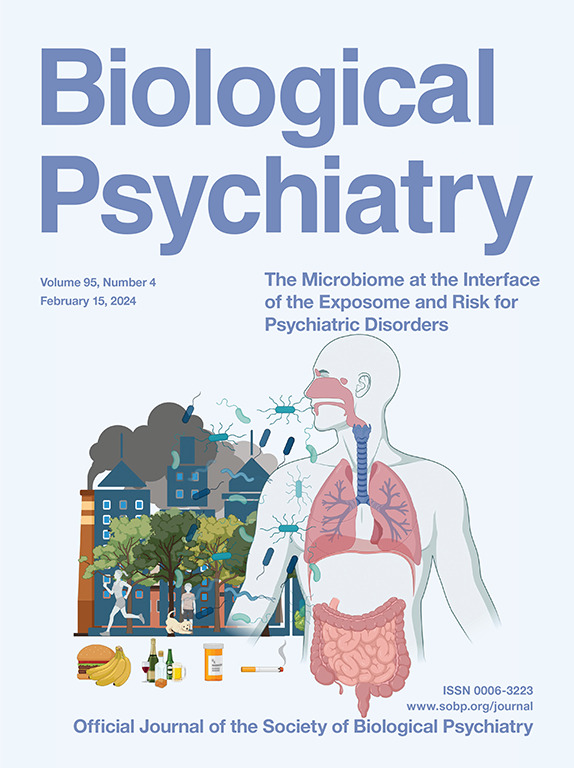Convergence on CaMK4: A Key Modulator of Autism-Associated Signaling Pathways in Neurons
IF 9.6
1区 医学
Q1 NEUROSCIENCES
引用次数: 0
Abstract
Although the precise underlying cause(s) of autism spectrum disorder remain unclear, more than 1000 rare genetic variations are associated with the condition. For many people living with profound autism, this genetic heterogeneity has impeded the identification of common biological targets for therapy development for core and comorbid traits that include significant impairments in social communication and repetitive and restricted behaviors. A substantial number of genes associated with autism encode proteins involved in signal transduction and synaptic transmission that are critical for brain development and function. CAMK4 is an emerging risk gene for autism spectrum disorder that encodes the CaMK4 (calcium/calmodulin-dependent protein kinase 4) enzyme. CaMK4 is a key component of a Ca2+-activated signaling pathway that regulates neurodevelopment and synaptic plasticity. In this review, we discuss 3 genetic variants of CAMK4 found in individuals with hyperkinetic movement disorder and comorbid neurological symptoms including autism spectrum disorder that are likely pathogenic with monogenic effect. We also comment on 4 other genetic variations in CAMK4 that show associations with autism spectrum disorder, as well as 12 examples of autism-associated variations in other genes that impact CaMK4 signaling pathways. Finally, we highlight 3 environmental risk factors that impact CaMK4 signaling based on studies of preclinical models of autism and/or clinical cohorts. Overall, we review molecular, genetic, physiological, and environmental evidence that suggest that defects in the CaMK4 signaling pathway may play an important role in a common autism pathogenesis network across numerous patient groups, and we propose CaMK4 as a potential therapeutic target.
CaMK4:神经元中自闭症相关信号通路的关键调节器。
虽然自闭症谱系障碍的确切病因尚不清楚,但有 1000 多种罕见的基因变异与这种疾病相关。对于大量患有严重自闭症的患者来说,这种遗传异质性阻碍了针对核心特征和合并特征(包括社交沟通能力严重受损以及重复性和限制性行为)开发疗法的共同生物靶点的确定。大量与自闭症相关的基因编码的蛋白质涉及对大脑发育和功能至关重要的信号转导和突触传递。CAMK4 是一种新出现的自闭症谱系障碍风险基因,它编码 Ca2+-钙调蛋白依赖性蛋白激酶-4(CaMK4)酶。CaMK4 是调节神经发育和突触可塑性的 Ca2+ 激活信号通路的关键组成部分。在这篇综述中,我们讨论了在运动机能亢进症和包括自闭症谱系障碍在内的合并神经症状患者中发现的三种 CAMK4 基因变异,它们很可能具有单基因致病作用。我们还评论了与自闭症谱系障碍有关的其他四种 CAMK4 基因变异,以及影响 CaMK4 信号通路的其他基因中与自闭症有关的十二种变异。最后,根据对自闭症临床前模型和/或临床队列的研究,我们重点介绍了影响 CaMK4 信号传导的三个环境风险因素。总之,我们回顾了分子、遗传、生理和环境方面的证据,这些证据表明 CaMK4 信号通路的缺陷可能在众多患者群体共同的自闭症发病网络中扮演重要角色,并提出将 CaMK4 作为潜在的治疗靶点。
本文章由计算机程序翻译,如有差异,请以英文原文为准。
求助全文
约1分钟内获得全文
求助全文
来源期刊

Biological Psychiatry
医学-精神病学
CiteScore
18.80
自引率
2.80%
发文量
1398
审稿时长
33 days
期刊介绍:
Biological Psychiatry is an official journal of the Society of Biological Psychiatry and was established in 1969. It is the first journal in the Biological Psychiatry family, which also includes Biological Psychiatry: Cognitive Neuroscience and Neuroimaging and Biological Psychiatry: Global Open Science. The Society's main goal is to promote excellence in scientific research and education in the fields related to the nature, causes, mechanisms, and treatments of disorders pertaining to thought, emotion, and behavior. To fulfill this mission, Biological Psychiatry publishes peer-reviewed, rapid-publication articles that present new findings from original basic, translational, and clinical mechanistic research, ultimately advancing our understanding of psychiatric disorders and their treatment. The journal also encourages the submission of reviews and commentaries on current research and topics of interest.
 求助内容:
求助内容: 应助结果提醒方式:
应助结果提醒方式:


